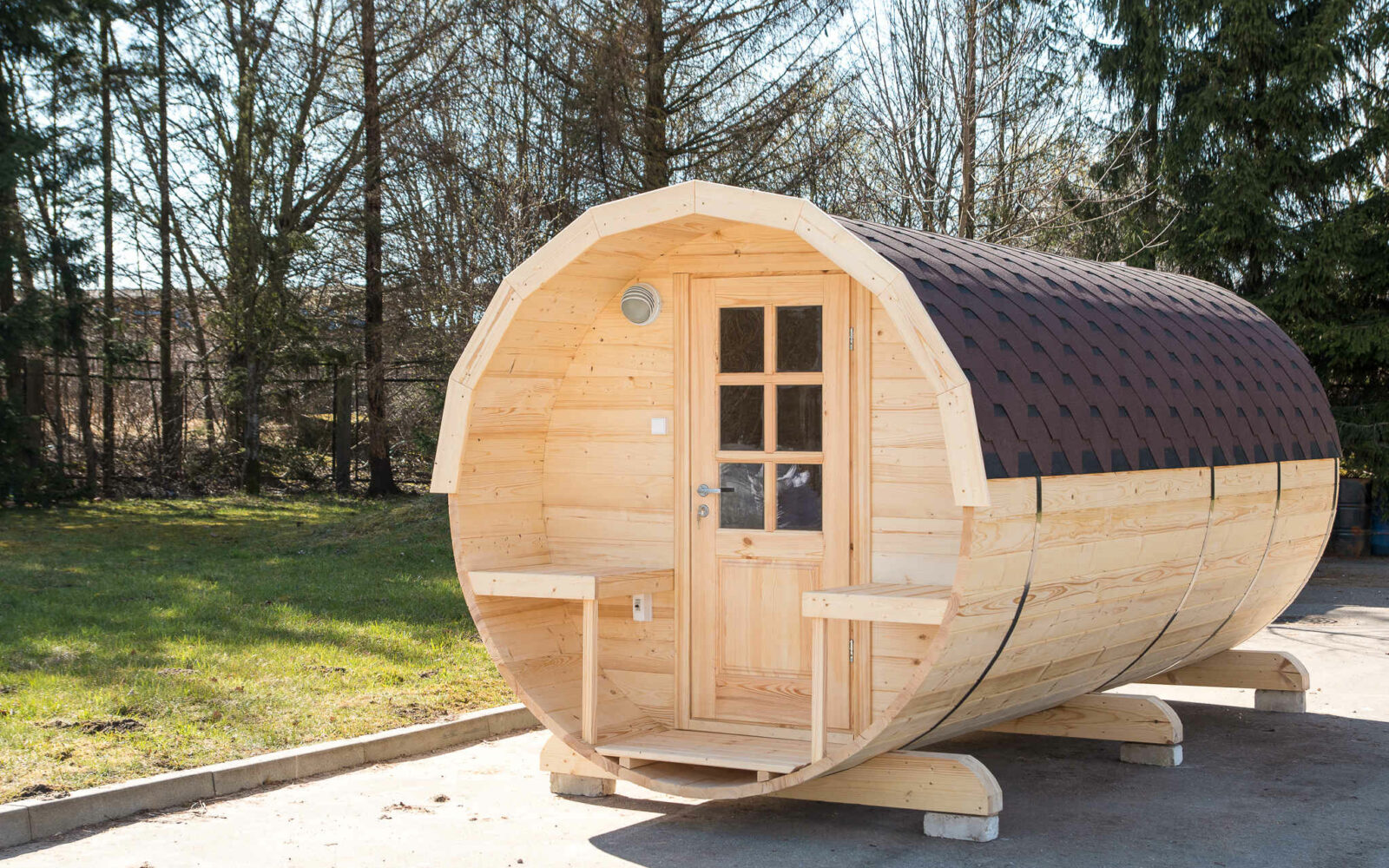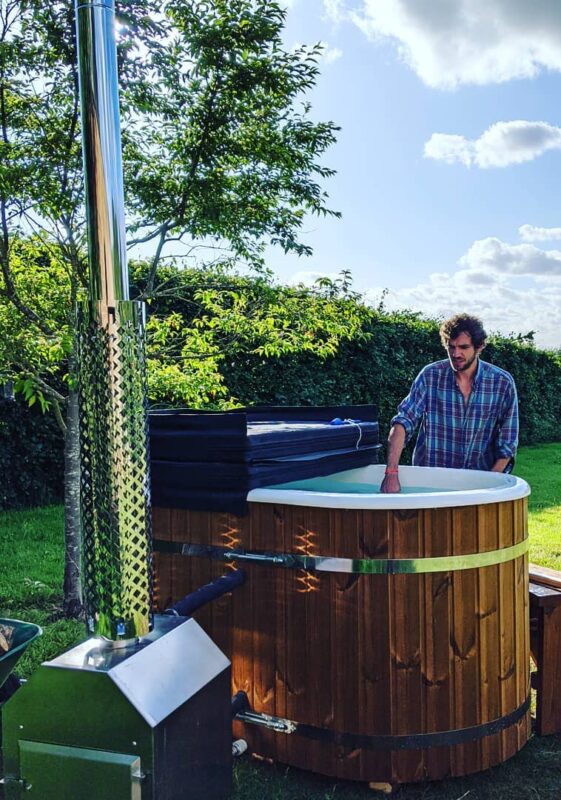All About Home Sauna

All about Home Sauna use
Just enjoy and relax…
1. Preface:
We’ve all heard the many different ideas and opinions when it comes to how to use a home sauna the ‘right’ way. Some are true, some are false, and some are half and half, so this booklet was created in hopes of assisting those who want to learn more about the various ways to use them.
You must remember that all of the following information are suggestions ONLY as over time you will find what works best for you. The main thing to note is that using a home sauna should be a relaxing and healthy hobby. With a large quantity of imitation devices and steam machines available on the market today, we will be delving into the one true sauna, the type you walk into and relax in.
2. General advice:
2.1 Are saunas healthy and will I lose weight?
Before we start, as mentioned above, there are a number of ideas that people have about saunas that need to be sorted. While people can lose a bit of weight through sauna use, they will NOT become thin simply for this reason. The minimal weight that people lose through saunas are really just bodily fluids or toxins that are being flushed out.
When you take part in a wooden sauna session, your body heats up up to 4 degrees higher than normal and as a result, your body begins to excrete sweat to cool down but never at such a rate that you feel dizzy or nauseous. If you suffer from some heart or blood pressure conditions however, consulting your GP beforehand is a safe bet. Your health and wellness will increase by taking part in wooden sauna sessions and word on the street is that it’s a great cure for hangovers! Feel the benefits of increased blood flow, and physical and mental relaxation!
2.2 How many times should I go?
The usual routine for most sauna users is once a week, and for some, two. The great thing is that the benefits and effects of using a sauna don’t wear off for a week, so the more you use it and keep your body primed, the less you will get sick. Beginners should always begin by sweating and cooling off two or three times during a session, and as their tolerance increases, so can their sessions.
2.3 How does a sauna heat up?
The steam and heat that makes up a sauna comes from an electric sauna oven that is comprised of special sauna stones. A small inlet is located below allowing fresh oxygen to enter and, in combination with the steam, creates a constant environment of, rich, oxygenated air. As the stones heat the room up, the air becomes warm and steams, creating the cleansing effect in your body. Strict standards are implemented when producing sauna stones as a balance of radiant AND convection heat is used to warm the sauna. In order to achieve this successfully, a number of factors are needed when choosing stones for your home sauna.
Ideally, whichever you select should have a high density and be heavily resistant against cracking or splitting. In order to achieve the required temperature for sweating and relaxation, you must first preheat the sauna 45 minutes prior to entering. Test if it’s ready by touching the benches or walls and see if they are warm and moist.
2.4 Coloured light stimulation
Coloured lights are often used to accompany saunas and steam baths due to the increased effects the light has on your body (and mind). Read on to find out about the four different colours used and the effects they have.
Green creates a calming and relaxing effect, causing you to feel more energetic and refreshed afterwards.
Red increases alertness and strengthens your physical body.
Blue has the same similar effect as green in regards to relaxation.
Yellow increases blood flow and stimulates your nerves.
2.5 Uses and types of sauna baths
2.5.1 Herbal sauna
A herbal sauna generally reaches temperatures of up to 40 to 45 degrees Celsius, with a humidity factor of up to 60% to 65%. Fresh herbs are stored inside a container or bowl, sometimes with a small water bath directly above the sauna oven. Gentle smells and inviting fragrances are slowly emitted from the herbs and increase the relaxing experience of the session.
2.5.2 Soft steam bath
A gentle steam bath generally reaches temperatures of up to 40 to 52 degrees Celsius, with a humidity factor of up to 48% to 62%. They can also be called bio saunas and are often used with the coloured lights mentioned earlier.
2.5.3 Warm air bath
A warm air bath generally reaches a temperature of up to 40 to 55 degrees celsius, with a humidity factor of up to 10% to 20%, due to a designated fresh air supply so no mist gathers while in the sauna.
2.5.4 Finnish sauna
The Finnish sauna is usually the sauna people are most familiar with. It is the ‘classic’ sauna most people have used which reaches temperatures of up to 80 to 100 degrees Celsius. Some of the Finnish saunas used water to create steam, while others a of a dry nature exist also. It is up to the individual to decide which one, and it is also interesting to note that these are the base saunas that people choose to infuse herbs with and create herbal saunas etc.
3. Your first sauna session
3.1 Introduction
The first time you decide to visit a sauna, it is best advised to set aside up to 3 hours and bring a sports bag along containing the following sauna gear:
- A bath towel
- Shower footwear
- Dry towels for after showers
- Sauna towel (absorbent enough for a lot of sweat!)
- Moisturizer to apply afterwards
When using a sauna, most people head to their nearest gym or swimming complex, so it would be smart to bring along some swimming gear if this is the case for you. Spas and pools are a great combination to a sauna session!
If you require, pack some of your grooming essentials such as your brush/comb, a good book or pastime, and also a bottle of water to complete the pack. Every time you visit, you should bring these with you and eventually, you will figure out what works best.
3.2 Should I eat before my sauna session?
As it is a laborious process on your body, even though you feel relaxed, you should only ever consume a small snack before attending a session. Indulging in heavy meals is not recommended as your digestive system will already be working hard enough as is. Also avoid eating garlic before heading as other patrons will definitely become irate with the odors leaving your body. Not a pleasant smell at all.
3.3 How do I prepare for a sauna?
Store everything that you won’t need for your sauna session in the available change rooms but remember to take your sauna bag with you. Any jewelry is bound to heat up intensely as you take part in a session so make sure all of it is removed prior. If you have glasses, either store them with your other gear or in the provided glasses compartment for users. Contacts are generally okay but must be kept moist in order to avoid irritation or burning and mobile phones as a pastime will cease to function due to all the water vapor in the room.
As for proper sauna use and hygiene, taking a shower before entering is the way to go. Not only does it remove all the oils and dirt from your body, but it keeps the sauna room clean for future users. Clean skin sweats better and in the point of maximizing your sessions, should be a priority. Perfumes and scents will evaporate quickly and all it will do is nauseate the other guests. Don’t try to impress them, just be clean. You should have had a tour of the facility you use by some of the staff before using but if you didn’t, getting familiar with the available accessories and facilities is important before heading in for the first time. You’ll find that many other guests are happy to share their sauna experiences and help build up your knowledge.
4. Your first sauna
When you enter the sauna for the first time, you will usually find a square or round room with two rows of benches, located above and below each other. Choosing a high bench will result in more heat and the opposite is true for lower benches. It is commonly advised to start at the lower benches and as your body adjusts to the heat, you can then rise up to suit your comfort level. Lay your towel down along the area you are going to sit or lie on as the number one rule of sweat cabins is; NO SWEATING ON THE WOOD!
If you begin to feel a little anxious or you feel like you have had enough then listen to your body. You don’t have to stay for the duration of the time limit and will gradually build up a tolerance to these sessions as your body adjusts. Your head generally gets hotter quicker than the rest of your body so if you feel lightheaded or you need to cool down, then go for it. First timers usually experience a need for a break after 8-12 minutes of their session.
4.1 The infusion
Infusion saunas are a little more heavy than straight forward saunas. Some users have described feeling nauseous or unwell, or simply feel uncomfortable when inside an herbal infused sauna. If this is the case, please leave the sauna immediately and try something a little lighter. If you need to hold the door open for your health then don’t be afraid to do so. It may affect others’ experience and will most likely tell you to close the door, so try to pick a time where this isn’t going to be a factor. Start slow and remember not to overload yourself too much on your first few times. Getting used to sauna temperatures and infusions is a gradual process so don’t feel the need to impress anyone or prove something to yourself. It is all about relaxation and health after all, not showmanship so just remember to enjoy it and nothing more.
Fragrances and infusions are the ideal way for most users who take part in sauna sessions and has many health benefits added to classic saunas. Usually the process is conducted with water, to slowly release the required scents. With the right application, these water saunas are known to last up to 15 minutes and can include using crushed ice for maximum efficiency as it evaporates slower than water. Along with the steam and mist included with the application, this is one of the BEST ways to enjoy a sauna if your body is up for it. Again remember never to force yourself into one of these situations.
4.1.1 Infusion additions
There are a number of different oils and scents that imitate nature and are used as infusion additions to your sauna experience. Users have reported being able to tell the difference between many different types and the effects they have on them, so choosing the right one helps. If you would like to know which oil or essence is being used there are usually noticeboards or information centers which allow you to find out. If not however, simply ask a staff member. There are many types of oils and essences used, such as:
- Rosemary
- Citrus- Orange, Lemon, Mandarin
- Herbs- Lavender, Balm, Camomile
- Eucalyptus
- Conifer oil
- Peppermint
- Fruit-Cherry, Plum, Apple, Strawberry
With many more choices besides these, users are guaranteed to find something to suit their own unique tastes.
4.1.2 The honey infusion
To add to your sauna experience, on top of the oils and essences, honey is passed around to guests in some saunas in order to apply it to their skin. This is a purifying method and works well with the steam so don’t be afraid to take part and look like a honeycomb.
4.1.3 Salt scrub
After the phase has been completed where your body heats up, various bath salts are able to be applied to your body (obviously avoiding your privates, eyes, and any cuts/burns/scrapes). It is important to note that it isn’t required to do in the sauna as you can also apply the salt in steam baths. Smoother and shinier skin is a direct result after more water and steam are applied to the sauna. This happens because outer, dead skin cells are scraped off with the salt when you have a shower.
4.1.4 Sweltering heat
This infusion is similar to the salt rub, but mint is mixed in and is then applied to your body offering a more relaxing scrub.
4.1.5 Alternative Infusions
These have more in common with perks rather than infusions but definitely add to the sauna experience. Fruit can be offered during the sauna or ice cream to help cool your body down and enable a longer session. Glasses of juice or filtered water offered after the sauna session are a welcome sight when exiting, as dehydration becomes an issue. Small things sure, but effective at enticing you to come back!
4.2 Any tips for cooling down?
When you begin the process of cooling down, it must be done to properly also to avoid any colds or flue, or dehydration issues. Your body will be in need of some fresh oxygen, free of steam and humidity so take as much in as possible, breathing in through your nose and out through your mouth. Lukewarm or cold showers are generally the best way to go for most sauna goers and cooling your extremities first and moving inwards is a better option. There are two common ways to cool down and are explained further below. Read on for more information.
4.2.1 Splashing sprinkler head
This is usually found in almost every sauna you end up using, which is a jet stream of water that comes out with low pressure. It is effective at cooling your body down slowly, as it is supposed to do.
4.2.2 The Kneipp hose
This is another common shower head often found in most homes where you actually grasp the hose in your hand and cool your body down one part at a time, moving it over your body slowly. You will want to take the cooling down process very seriously as you don’t want to be sweating all over your clothes afterwards. Keep the hose in a circular motion and also do the same when applying it to your head to get every area.
4.3 Foot baths
Warming your feet in a cold or lukewarm foot bath is a great way to restore balance to your stability. Using warm water engages stimulation in your feet and creates a relaxing feeling throughout your body.
the whole body.
4.4 Relaxation Rooms
A sauna is one of the most ideal way to relax and is utilized by many people all over the globe. It has been used for thousands of years and its health benefits have been documented time and time again. Not only do you relax when in a sauna, but you must relax while taking breaks and cooling down in order to avoid some injuries. Relaxation rooms are commonly found in most sauna facilities and have some couches or other furniture to relax and unwind in.
Heated couches and meditation areas are prevalent throughout these areas too. After your first few sessions, you should definitely hit the relaxation room a few times, and try to keep it part of your sauna routine. Why not take advantage of all the extras and accessories that are provided to you during your sauna visit?
4.5 Drinking
As mentioned previously, you will lose A LOT of bodily fluid when subjecting yourself to sauna sessions and there are many divided opinions on whether you should drink during your session. One theory is that you should drink lot of water during so that you are doubly cleansed, while others think that if you drink water, all you will sweat is water. The truth, as always, tends to lie somewhere in the middle. Try not to drink too much water but if you are thirsty then your body is begging for water, so indulge it!
When your sauna session is over, it is advised to drink as much water as possible to replenish what you have lost. Water is the most important requirement for our bodies. While water is deemed the best option, it is up to the individual user to decide which drink is best for them. Some opt for Gatorade type sports replenishers, others opt for flavored water. As long as your water content and strength are regained, it really doesn’t matter.
5. Conclusion
There are many places that go above and beyond when it comes to offering services or events for their customers. Sauna breakfasts, midnight saunas, BBQ evenings, Finnish sauna nights, and other themes are common occurrences for guests to indulge in, and keep coming back. Check out what your local sauna has to offer and if there is nothing, why not organize things yourself with the help of the complex? Enjoy your sauna experience with the knowledge you have acquired here today! Remember to relax and have fun!


